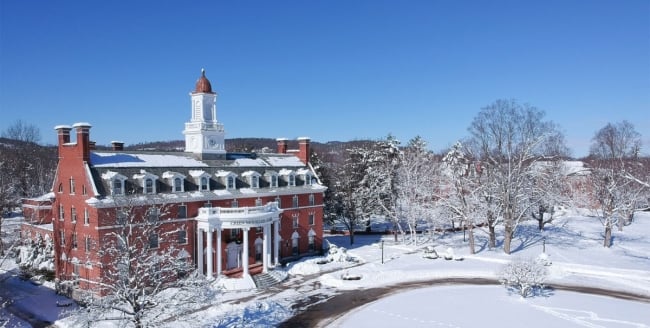You have /5 articles left.
Sign up for a free account or log in.

Green Mountain College
Draw up a list of characteristics putting a college at risk of shutting down, and Green Mountain College would check almost every box.
Small private college? Green Mountain enrolled fewer than 500 undergraduates last year. Tiny endowment? Funds totaled less than $3 million in 2017. Rural location? The college is in Poultney, Vt., a town on the border of upstate New York in a county where the population has been declining -- and where just 63.5 people live per square mile, on average.
Now, draft a list of the popular strategies private colleges are using to try to stave off closure. Green Mountain would check an awful lot of those boxes, too.
That’s a sobering fact for higher education observers who have watched small private colleges post one shutdown announcement after another in the last year.
Leaders, especially those in the Northeast, have known for some time that demographic changes leave them recruiting from a smaller pool of the students who have traditionally attended college in large numbers -- and who have been able to pay substantial sums for tuition. But those leaders felt they could still take steps to bolster their standing with a subset of existing students, add new programs to attract new types of students and strengthen their balance sheets to set themselves up to succeed in the face of headwinds.
Green Mountain’s closure would seem to call that into question.
The college had carved out a niche, focusing on what it called the environmental liberal arts. Developing a niche or signature program is often identified as a smart way to differentiate a campus and grab the attention of students.
Green Mountain started offering online graduate master’s programs in 2006. And it had come to rely on graduate programs for a substantial number of its students -- by the fall of 2017, more than 35 percent of its enrollment was graduate students, according to federal data. It had 256 graduate students and 468 undergraduates.
More recently, the college refinanced its debt in April, taking out a $19.5 million, 35-year loan with a low 3.25 percent fixed interest rate through a U.S. Department of Agriculture program. USDA lending has become a go-to source of cheap capital for pressured small colleges in rural areas that need relief from high debt costs and don’t have many other borrowing options. Such loans can beat financing terms available elsewhere and, more importantly, free up substantial sums of money within tight annual budgets.
It apparently wasn’t enough. Green Mountain didn’t respond to requests for comment after announcing on Wednesday that it would close at the end of the spring semester. But a statement posted online from its president, Robert W. Allen, noted that the college had been through a “tireless pursuit of multiple options” that included seeking partnerships and reorganizing its finances.
Financial challenges are hitting liberal arts institutions across the country, Allen’s statement continued. He pointed to major changes in demographics and cost structures as being behind Green Mountain’s decision to close.
His comments echo those of other college leaders, in the Northeast and elsewhere. But New England has experienced a striking number of liberal arts college closure announcements of late.
In Massachusetts, Hampshire College said this month it is considering not enrolling freshmen in the fall and it is seeking a partner in the face of what its president called “bruising financial and demographic realities.”
Hampshire’s news came on the heels of Newbury College saying in December that it would shut down its Boston-area campus at the end of the spring 2019 semester. Also in the last calendar year in Massachusetts, Wheelock College merged into Boston University and Atlantic Union College announced closure plans. Notably, Mount Ida College also grabbed headlines with a sudden closure last spring that left students surprised and unsure where they could finish their degrees.
The spate of colleges closing their doors -- and Mount Ida’s collapse -- has led Massachusetts regulators to explore ways to make sure students are protected when a college’s finances force it to close. Just this week a working group came out with recommendations that the state’s Department of Higher Education will use to try to establish a system that would screen colleges for problems and give students advance notification that finances are failing.
“My goal isn’t to be a national leader,” said Chris Gabrieli, chairman of the Massachusetts Board of Higher Education. “My goal is to do the right thing for Massachusetts. But I can’t believe this isn’t an issue in other states.”
Demographic trends being what they are, more closures are in fact expected in the region.
“From all external indications, it’s going to get bad, and very bad for these smaller, tuition-dependent institutions without a strong brand name,” said Larry Ladd, national director for the higher education practice at the consulting giant Grant Thornton, who is based in Boston.
Small colleges don’t have a broad base to draw upon when times get tough, Ladd said. They generally have fewer donors to tap than would a larger institution, and they enroll fewer students from whom to draw tuition revenue or fees.
Indeed, auditors flagged Green Mountain’s fund-raising concentration in a 2017 report, writing that a significant portion of contributions receivable were due from one donor. The college was also giving back 50 cents for every dollar it collected from students in tuition, counting more than $9 million in financial aid and scholarships against $18.3 million in tuition revenue. A 50 percent discount rate isn't shockingly high compared to undergraduate discount rates at many small private liberal arts colleges, which sometimes spike into the 60 percent range, but the numbers in the auditor's report would also include graduate tuition collected, which could skew the percentages. Nonetheless, many other institutions may still have a higher overall discount rate, although Green Mountain's small size may have given it less room to work with when trying to attract students through discounting.
While it had other sources of revenue, like conferences and room and board, they weren’t making enough profit to stuff the balance sheet. Conference revenue totaled just over $602,325 versus expenses of $287,090 for the year ending in June 2017. Room and board revenue was $4.5 million against dining hall and dormitory expenses of $4.8 million.
There simply weren’t many other sources of money in a budget that totaled $18.5 million. Green Mountain managed to eke out an operating surplus of about $150,000 in 2017, but it lost money in the prior year.
Finding a niche by emphasizing the environment seems to be something that would be a smart step for a college like Green Mountain, Ladd said. But such a move can come with drawbacks. While it hopefully increases the intensity of interest from some students, it can also narrow the pool of interested students. Finding those students can in turn be costly.
For a very small, isolated college in Vermont, even small drawbacks to sound strategies can add up, especially when demographics turn south.
And demographic trends very clearly have gone south for colleges in the Northeast. Vermont in particular is in the midst of a prolonged decline in the number of high school graduates, according to projections from the Western Interstate Commission for Higher Education. That’s before slicing the data to see which students are still likely to be graduating and whether they can be expected to enroll in higher education -- or in small private liberal arts colleges.
Nathan Grawe, a professor of economics at Carleton College, conducted some of those analyses for his book Demographics and the Demand for Higher Education (Johns Hopkins University Press). In part, he projected declining demand from students across the Northeast for virtually all types of college through 2029.
Even before birth rates fell across the country during the Great Recession, births lagged deaths in Vermont.
“In 2007, when the country was experiencing the birth boom, the state with the lowest fertility rate was Vermont,” Grawe said in an interview. “They weren’t coming anywhere near close to the replacement-rate level of fertility.”
If the discussion leaves college leaders feeling pessimistic, Grawe offers the reminder that demographics do not have to be destiny.
“Is demographic change going to lead to closure throughout the industry?” he asked. “That’s hard to know. It depends in part on how people respond to the challenges we face.”
What has become clear is that for at least one small college in Vermont, a set of common responses to industrywide challenges didn’t work.
At this point, it’s hard to say exactly why they didn’t work at Green Mountain -- or whether any other courses of action would have allowed the college to keep its doors open.
“Whether they executed them well or did it too late, I don’t know,” Ladd said.




